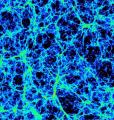
Boundary condition

Posts: 8617 Joined: 30-Aug-2008 Last visit: 29-Nov-2025 Location: square root of minus one
|
In a recent test, it was found that Freebase DMT was extremely soluble in 90% ethanol. 400mg of DMT dissolved very easily in 1mL of alcohol. It was clear that half the amount would have done the job. Dropwise addition of 20% aqueous ethanol at room temperature produced an initial clouding which rapidly cleared. Thus this cannot be used as a precipitation method for DMT freebase! The 2mL of DMT solution in 55% ethanol was placed in a freezer at -18°C. After an adequate cooling time, the solution was observed to have separated into an upper clear layer and a lower orange-yellow layer. That is where this experiment stands right now. It will be instructive to separate the two layers and observe what has partitioned between them. Updates if and when further results are obtained. “There is a way of manipulating matter and energy so as to produce what modern scientists call 'a field of force'. The field acts on the observer and puts him in a privileged position vis-à-vis the universe. From this position he has access to the realities which are ordinarily hidden from us by time and space, matter and energy. This is what we call the Great Work." ― Jacques Bergier, quoting Fulcanelli
|
|
|
|
|

DMT-Nexus member

Posts: 14191 Joined: 19-Feb-2008 Last visit: 22-Nov-2025 Location: Jungle
|
Thanks for posting the results! I wonder if dropwise addition of water might make the dmt precipitate, maybe together with fridge/freezer.. That'd be an amazing way to finish up the alcohol/vinegar tek if it works Let us know if you further these experiments 
|
|
|

Boundary condition

Posts: 8617 Joined: 30-Aug-2008 Last visit: 29-Nov-2025 Location: square root of minus one
|
I've got my fingers crossed on this. I've pondered of late how the common lab practice of recrystallising from hot, aqueous ethanol might be applied to DMT with it's somewhat low melting point(s). Thus combining knowledge of freeze precipitation from naphtha with the idea that thermal solubility gradients might also apply to DMT in aqueous ethanol led to this idea. I'm actually hoping that 37.5% might turn out to be optimum for this. Then we could recrystallise from vodka...  “There is a way of manipulating matter and energy so as to produce what modern scientists call 'a field of force'. The field acts on the observer and puts him in a privileged position vis-à-vis the universe. From this position he has access to the realities which are ordinarily hidden from us by time and space, matter and energy. This is what we call the Great Work." ― Jacques Bergier, quoting Fulcanelli
|
|
|

Boundary condition

Posts: 8617 Joined: 30-Aug-2008 Last visit: 29-Nov-2025 Location: square root of minus one
|
So I finally got around to dragging this little experiment back out of the freezer. The method could do with a few improvements as I will detail below. It seems likely that the clear upper layer was the water-rich phase and the yellow lower layer the DMT rich one but currently it is impossible to tell. The two layers became miscible on slight warming so use of an freezing mixture bath would be desirable to improve their separation. A tall, thin container would also be desirable to aid separation as the container used was too wide for the tiny volume of solution, again making separation of the layers difficult. It was possible to get some level of separation of the more viscous, yellow, lower layer but the upper, clear, limpid layer quickly picked up a lot of colour as the temperature rose. This was very reminiscent of the way warming naphtha with an oily layer of orange DMT beyond a certain temperature will cause the two phases to combine to a single yellow one. The two layers were transferred into two separate, pre-weighed 5mL measuring cylinders using a glass Pasteur pipette. The volumes were equalised as best they could be and each cylinder weighed again. The difference in weight was found to be approximately 40mg, with the top being the heavier (this is clearly an error). It is difficult to infer much about the overall partitioning of the (400mg) DMT between the two layers due to the problem of mixing and the unknown densities of the solvent components of the two layers, not to mention the lack of cross-calibration between the two measuring cylinders as well as the difficulty of accurate measurement of the small volumes of liquid used with the available equipment. The extreme solubility of DMT in ethanol seems to indicate that a very low percentage of ethanol in water may be required for successful thermal gradient precipitation of solid DMT freebase from aqueous ethanol, if it is likely to work at all. It seems equally likely that DMT freebase would separate as a viscous yellow oil along with the ethanol present. If this separation can be adequately maintained at above refrigerator temperatures then there is still a possibility that this could be developed as a useful technique. If the intention is to separate the freebase from sodium carbonate paste, it is difficult to see how this could be successful unless it is possible to precipitate the DMT by freezing it out from an aquo-ethanolic solution of sodium carbonate. Next step: try adding more water to the (recombined) solution. After that: evaporate all solvent to recover solids. Photos below. downwardsfromzero attached the following image(s):  IMG_8619.JPG (4,429kb) downloaded 251 time(s). IMG_8626.JPG (3,588kb) downloaded 250 time(s). IMG_8629.JPG (3,790kb) downloaded 249 time(s). IMG_8631.JPG (3,213kb) downloaded 248 time(s). “There is a way of manipulating matter and energy so as to produce what modern scientists call 'a field of force'. The field acts on the observer and puts him in a privileged position vis-à-vis the universe. From this position he has access to the realities which are ordinarily hidden from us by time and space, matter and energy. This is what we call the Great Work." ― Jacques Bergier, quoting Fulcanelli
|
|
|

Boundary condition

Posts: 8617 Joined: 30-Aug-2008 Last visit: 29-Nov-2025 Location: square root of minus one
|
OK, so I've tried again and had better success separating the two phases by standing the container on a gel icepack. Weights of bottom layer and top layer respectively were: 0.81g and 0.85g. Volumes were 0.8mL and 0.91mL. This gives density values of 1.01g/mL fro the bottom layer and 0.93g/mL for the top layer. The two layers in their measuring cylinders have been returned to the freezer to see if any further separation occurs. Photo attached: bottom layer is on the right, obviously a much deeper yellow colour. downwardsfromzero attached the following image(s):  IMG_8633.JPG (3,061kb) downloaded 235 time(s). “There is a way of manipulating matter and energy so as to produce what modern scientists call 'a field of force'. The field acts on the observer and puts him in a privileged position vis-à-vis the universe. From this position he has access to the realities which are ordinarily hidden from us by time and space, matter and energy. This is what we call the Great Work." ― Jacques Bergier, quoting Fulcanelli
|
|
|

❤️🔥
 
Posts: 3648 Joined: 11-Mar-2017 Last visit: 11-Dec-2025 Location: 🌎
|
If you add ammonium sulfate (40% or until it starts to saturate) the layers should separate well. Also, the DMT partition will be boosted towards the solvent I think. Very little ammonium sulfate should be picked up in the ethanol layer. Any that is there should be removable with a dry followed by denatured alcohol pickup and final dry. Instead of ethanol, cheap IPA (2-propanol) should work too I think. The attached paper may be useful. One thing to keep an eye on is the pH, ammonium sulphate can lower it, but that is adjustable with ammonia I believe. Ammonium sulphate as is used as a fertilizer and food aditive, should be easy to get. If considering using ferilizer only use one that has good spec limits for heavy metals. Edit: I see endlesness mentioned adding water to crash freebase out. Maybe salt water can be tried as ethanol should remain miscilbe in salt water (but not IPA). However, if precipitation does happen, I'm not sure how to clean up any salt residue.
|
|
|

Boundary condition

Posts: 8617 Joined: 30-Aug-2008 Last visit: 29-Nov-2025 Location: square root of minus one
|
Thanks for the input! I'm planning on adding a little more water to the yellow portion to see what can be nudged out. Still picking up the threads after a recent holiday, though. Maybe it'll be worth tracking down some ammonium sulfate in the long run. The next experiment will probably be an investigation of what happens when using normal vodka (37.5% ethanol) as the solvent, along with heating and cooling. “There is a way of manipulating matter and energy so as to produce what modern scientists call 'a field of force'. The field acts on the observer and puts him in a privileged position vis-à-vis the universe. From this position he has access to the realities which are ordinarily hidden from us by time and space, matter and energy. This is what we call the Great Work." ― Jacques Bergier, quoting Fulcanelli
|
|
|

DMT-Nexus member
Posts: 975 Joined: 24-Jan-2015 Last visit: 17-Aug-2025
|
Loveall wrote:If you add ammonium sulfate (40% or until it starts to saturate) the layers should separate well. Also, the DMT partition will be boosted towards the solvent I think.
Very little ammonium sulfate should be picked up in the ethanol layer. Any that is there should be removable with a dry followed by denatured alcohol pickup and final dry.
Why does ammonium sulfate assist the two ethanol layers to separate?
|
|
|

Boundary condition

Posts: 8617 Joined: 30-Aug-2008 Last visit: 29-Nov-2025 Location: square root of minus one
|
fathomlessness wrote:Why does ammonium sulfate assist the two ethanol layers to separate? It increases the polarity of the aqueous phase which then pushes out the less polar component. (My how time has rumbled on since I started this!) There were results from the separation of the upper and lower phases, followed by allowing all the liquid to evaporate. They need digging out from my notes and posting here. To summarise, in the end it was effective in separating virtually all the DMT. “There is a way of manipulating matter and energy so as to produce what modern scientists call 'a field of force'. The field acts on the observer and puts him in a privileged position vis-à-vis the universe. From this position he has access to the realities which are ordinarily hidden from us by time and space, matter and energy. This is what we call the Great Work." ― Jacques Bergier, quoting Fulcanelli
|